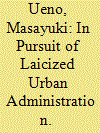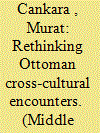|
|
|
Sort Order |
|
|
|
Items / Page
|
|
|
|
|
|
|
| Srl | Item |
| 1 |
ID:
186579


|
|
|
|
|
| Summary/Abstract |
The Ottoman Empire introduced the muhtar system in Istanbul in 1829, appointing lay headmen, called muhtar, to the lowest levels of urban administration: Muslim neighborhoods; Orthodox, Armenian, and Catholic parishes; and Jewish congregations. This reform resulted in the overlapping of state responsibilities and those of non-Muslim religious authorities, later leading to disputes between the groups. This article investigates such disagreements in an effort to understand how state officials perceived non-Muslim religious authorities’ participation in imperial governance. In so doing, this article argues that, as non-Muslim political movements began developing during the late nineteenth century, state officials adopted a cautious attitude toward non-Muslim clergy, viewing the latter as requiring more careful handling than the layman. This take on clergymen was a shift, a reconsideration of the exceptional treatment they had previously enjoyed, and ignited a growing desire to sever the ties, formerly tolerated, between muhtars and religious authorities.
|
|
|
|
|
|
|
|
|
|
|
|
|
|
|
|
| 2 |
ID:
139126


|
|
|
|
|
| Summary/Abstract |
This article aims to show how and why Armeno-Turkish, or Ottoman Turkish written in Armenian letters, especially throughout the nineteenth century, was not merely an Armenian phenomenon but rather a cultural reflection of a larger Ottoman history. The article begins with a critique of the literature on the Ottoman millets and the interaction among them. It then presents examples of Turkish statesmen, authors, and journalists who were either aware of or could read Armeno-Turkish, and explores how Armeno-Turkish might have served as a written lingua franca among the members of different ethnic, religious, and linguistic groups in the Ottoman Empire. Finally, it concludes with a number of reflections on the possible reasons for Turksʼ interest in the Armenian script. The article thus aims to contribute to the debate over the Ottoman millet system from the perspective of cross-cultural exchanges and encounters among the different peoples of the Ottoman Empire.
|
|
|
|
|
|
|
|
|
|
|
|
|
|
|
|
|
|
|
|
|